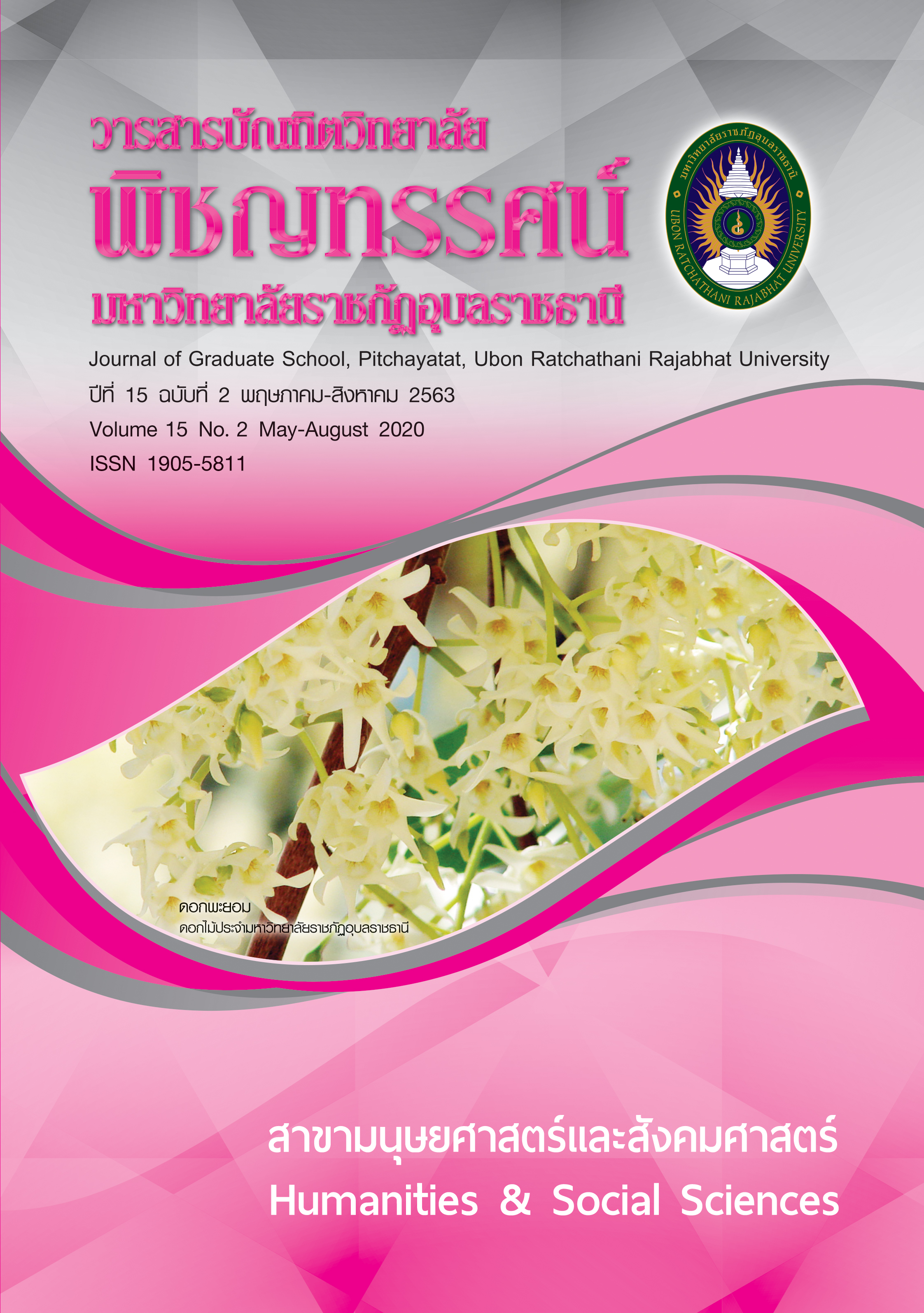การพัฒนารูปแบบการจัดการเรียนรู้คณิตศาสตร์ตามแนวคิดการสร้างความรู้ เพื่อพัฒนาความสามารถในการแก้ปัญหาอย่างสร้างสรรค์ของนักเรียนชั้นมัธยมศึกษาปีที่ 2
คำสำคัญ:
รูปแบบการจัดการเรียนรู้, แนวคิดการสร้างความรู้, ความสามารถในการแก้ปัญหาอย่างสร้างสรรค์บทคัดย่อ
การวิจัยนี้มีวัตถุประสงค์เพื่อ 1) พัฒนารูปแบบการจัดการเรียนรู้คณิตศาสตร์ตามแนวคิดการสร้างความรู้เพื่อพัฒนาความสามารถในการแก้ปัญหาอย่างสร้างสรรค์ของนักเรียนชั้นมัธยมศึกษาปีที่ 2 และ 2) ศึกษาผล
ใช้รูปแบบการจัดการเรียนรู้คณิตศาสตร์ตามแนวคิดการสร้างความรู้เพื่อพัฒนาความสามารถในการแก้ปัญหาอย่างสร้างสรรค์ของนักเรียนชั้นมัธยมศึกษาปีที่ 2 การวิจัยนี้เป็นการวิจัยและพัฒนา โดยมีวิธีการดำเนินการวิจัยแบ่งเป็น 4 ระยะ คือ ระยะที่ 1 การศึกษาข้อมูลเบื้องต้นเกี่ยวกับการจัดการเรียนรู้ ระยะที่ 2 การพัฒนารูปแบบการจัดการเรียนรู้ ระยะที่ 3 การทดลองใช้รูปแบบการจัดการเรียนรู้ ระยะที่ 4 การประเมินผลและปรับปรุง โดยตัวอย่างที่ใช้ทดลองคือ นักเรียนที่กำลังศึกษาอยู่ในชั้นมัธยมศึกษาปีที่ 2 ภาคเรียนที่ 2 ปีการศึกษา 2561 โรงเรียนระยองวิทยาคม จำนวน 50 คน ซึ่งได้มาโดยการสุ่มแบบกลุ่ม เครื่องมือที่ใช้ในการทดลอง คือ แผนการจัดการเรียนรู้ แบบทดสอบวัดความสามารถในการแก้ปัญหาอย่างสร้างสรรค์เรื่องการประยุกต์ของสมการเชิงเส้นตัวแปรเดียว และแบบทดสอบวัดผลสัมฤทธิ์ทางการเรียนคณิตศาสตร์เรื่องการประยุกต์ของสมการเชิงเส้นตัวแปรเดียว สถิติที่ใช้ได้แก่ ค่าเฉลี่ย ส่วนเบี่ยงเบนมาตรฐาน และการทดสอบที
ผลการวิจัยพบว่า
- รูปแบบการจัดการเรียนรู้คณิตศาสตร์ตามแนวคิดการสร้างความรู้เพื่อพัฒนาความสามารถใน
แก้ปัญหาอย่างสร้างสรรค์ของนักเรียนชั้นมัธยมศึกษาปีที่ 2 มีองค์ประกอบ 4 องค์ประกอบคือ หลักการ จุดมุ่งหมาย ขั้นตอนการจัดการเรียนรู้และการวัดและประเมินผล ซึ่งผลการประเมินคุณภาพรูปแบบการจัดการเรียนรู้โดยผู้เชี่ยวชาญ พบว่า รูปแบบการจัดการเรียนรู้มีความเหมาะสมในระดับมาก - ผลของการใช้รูปแบบการจัดการเรียนรู้คณิตศาสตร์ตามแนวคิดการสร้างความรู้เพื่อพัฒนาความสามารถในการแก้ปัญหาอย่างสร้างสรรค์ของนักเรียนชั้นมัธยมศึกษาปีที่ 2 พบว่า นักเรียนมีความสามารถในการแก้ปัญหาอย่างสร้างสรรค์ หลังเรียนสูงกว่าก่อนเรียนอย่างมีนัยสำคัญทางสถิติ นักเรียนมีความสามารถใน
แก้ปัญหาอย่างสร้างสรรค์หลังเรียนสูงกว่าเกณฑ์ 80% อย่างมีนัยสำคัญทางสถิติ นักเรียนมีผลสัมฤทธิ์ทางการเรียนวิชาคณิตศาสตร์หลังเรียนสูงกว่าก่อนเรียนอย่างมีนัยสำคัญทางสถิติ และนักเรียนมีผลสัมฤทธิ์ทางการเรียนวิชาคณิตศาสตร์ หลังเรียนสูงกว่าเกณฑ์ร้อยละ 80 อย่างมีนัยสำคัญทางสถิติ
คำสำคัญ: รูปแบบการจัดการเรียนรู้ แนวคิดการสร้างความรู้ ความสามารถในการแก้ปัญหาอย่างสร้างสรรค์
เอกสารอ้างอิง
ทิศนา แขมมณี. ศาสตร์การสอน: องค์ความรู้เพื่อการจัดกระบวนการเรียนรู้ที่มีประสิทธิภาพ. พิมพ์ครั้งที่ 21. กรุงเทพฯ: สำนักพิมพ์จุฬาลงกรณ์มหาวิทยาลัย, 2560.
บุษบา พลรัตน์. “การศึกษาความสามารถการแก้โจทย์ปัญหาและผลสัมฤทธิ์ทางการเรียนของนักเรียน ชั้นมัธยมศึกษาปีที่ 2 เรื่อง อัตราส่วนและร้อยละโดยใช้วิธีสอนตามแนวคิดทฤษฎีคอนสตรัคติวิสต์ที่เน้นขั้นตอนการแก้ปัญหาของโพลยา,” วารสารศึกษาศาสตร์ มหาวิทยาลัยขอนแก่น. 6, 2 (เมษายน-มิถุนายน 2555): 80.
พรสวรรค์ วงศ์ตาธรรม.“การคิดแก้ปัญหาเชิงสร้างสรรค์ ทักษะการคิดในศตวรรษที่ 21,” วารสารศึกษาศาสตร์ มหาวิทยาลัยขอนแก่น. 38, 2 (เมษายน-มิถุนายน 2558): 111.
ฟาฏินา วงศ์เลขา. การเรียนคณิตศาสตร์ : ความจำเป็นที่ไม่ควรมองข้าม. (ออนไลน์) 2552 (อ้างเมื่อ 7 มกราคม 2552). จาก: http://www.moe.go.th/moe/th/news/detail.php?NewsID=5748&Key=hotnews
ส่งเสริมการสอนวิทยาศาสตร์และเทคโนโลยี, สถาบัน. ทักษะและกระบวนการทางคณิตศาสตร์. พิมพ์ครั้งที่ 3. กรุงเทพฯ: คิวมีเดีย, 2555ก.
ส่งเสริมการสอนวิทยาศาสตร์และเทคโนโลยี, สถาบัน. การวัดผลประเมินผลคณิตศาสตร์. กรุงเทพฯ: ซีเอ็ดยูเคชั่น, 2555ข.
เลขาธิการสภาการศึกษา, สำนักงาน. สภาวการณ์การศึกษาไทยในเวทีโลก พ.ศ. 2559/2560. กรุงเทพฯ: สำนักงานเลขาธิการสภาการศึกษา กระทรวงศึกษาธิการ, 2561.
ศึกษาธิการ, กระทรวง. PISA รั้งท้ายเหตุ’อ่าน-ตีโจทย์’ไม่แตก สกว.เผยผลวิจัยเด็กไทยคิดวิเคราะห์ต่ำมาก. (ออนไลน์) 2559 (อ้างเมื่อ 14 ธันวาคม 2559). จาก: https://www.moe.go.th/moe/th/news/detail.php?NewsID=47008&Key=hotnews
อลงกรณ์ ตั้งสงวนธรรม. “หลักการสอนและจิตวิทยาที่ควรรู้สำหรับครูคณิตศาสตร์,” ใน: อริศรา แก่นอ้วน, บรรณาธิการ. ประมวลสาระชุดวิชาการจัดประสบการณ์การเรียนรู้คณิตศาสตร์ สาขาวิชาศึกษาศาสตร์มหาวิทยาลัยสุโขทัยธรรมาธิราช หน่วยที่ 1-8 (35-36). นนทบุรี: มหาวิทยาลัยสุโขทัยธรรมาธิราช, 2554.
Eggen, P. and Kauchak, D. Educational Psychology: windows on classrooms. 8th ed. New Jersey: Pearson Education, 2010.
Heleni, S. “Application Model Learning Creative Problem Solving (CPS) Math Learning To Improve Results Class VIII SMPN 3 Pekanbaru,” International Seminar on Innovation in Mathematics and Mathematics Education 1st ISIM-MED 2014. 19, 1 (2014): 553-562.
Rickey, R.C., Klein, J.D., and Tracey, M.W. The Instructional Design Knowledge Base: Theory, research, and practice. New York: Routledge, 2011.
Woolfolk, A. Educational psychology. 13th ed. New York: Pearson Education, 2016.
ดาวน์โหลด
เผยแพร่แล้ว
รูปแบบการอ้างอิง
ฉบับ
ประเภทบทความ
สัญญาอนุญาต
บทความทุกเรื่องได้รับการตรวจความถูกต้องทางวิชาการโดยผู้ทรงคุณวุฒิภายนอกอย่างน้อย 2 คน ความคิดเห็นในวารสารบัณฑิตวิทยาลัย พิชญทรรศน์ มหาวิทยาลัยราชภัฏอุบลราชธานี เป็นความคิดเห็นของผู้เขียนมิใช่ความคิดเห็นของผู้จัดทำ จึงมิใช่ ความรับผิดชอบของบัณฑิตวิทยาลัย มหาวิทยาลัยราชภัฏอุบลราชธานี และบทความในวารสารบัณฑิตวิทยาลัย พิชญทรรศน์ มหาวิทยาลัยราชภัฏอุบลราชธานี สงวนสิทธิ์ตามกฎหมายไทย การจะนำไปเผยแพร่ต้องได้รับอนุญาตเป็นลายลักษณ์อักษรจากกองบรรณาธิการ






